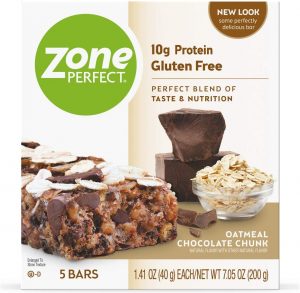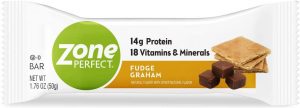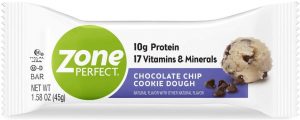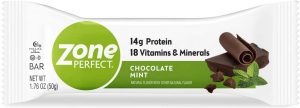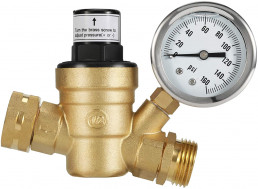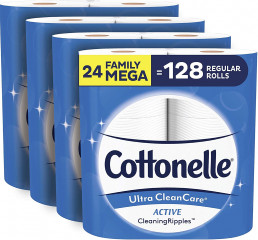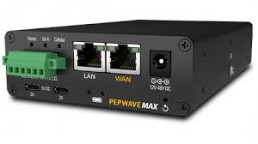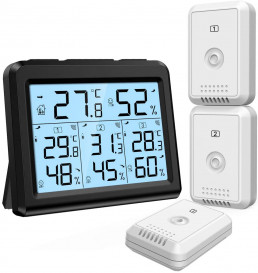Water Regulation - Definitely!
When we lived in our house, we didn't think much about water. You call the water department, get your service on and thats about it. But the world is a bit different for travelers. The quality and quantity of water you get from any RV park or random water source can vary significantly. Because of this you will want to get a water regulator - The PEX and plastic pipes in your RV cannot withstand high pressures and you can end up with a serious leak and expensive damage to your home. And no one wants that! We went with a pretty cheap option - Around $22 when we bought it on Amazon: For our motorhome, we use the Kohree RV water pressure valve.
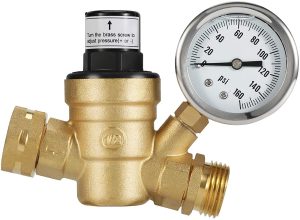
The reality is that most of the cheap regulators on Amazon are getting pumped out of a couple Chinese factories and are just that - cheap. This one seems to work fine, although our pressure has dropped at the tap (maybe we need to set the pressure higher, but it could be flow restriction issue with this valve). You could try to adapt a household regulator like this Zurn Wilkins - but that seems like wasted effort for something that is effectively a consumable at $22!
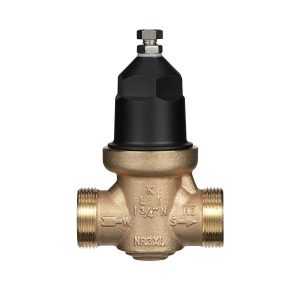
RV Toilet Paper - The Dirty Truth
Why is toilet paper a big deal in an RV? One very simple reason - if you clog up your black tank, you are going to have a very big mess on your hands. Unlike a house, every RV has a holding tank for your solids and liquids. When you clog a toilet in a house, you can usually fix it with a plunger, or an auger if it is especially bad. But in most cases, the issue won't be too bad because toilet paper flows through the smooth pipes in the house and out to the local sewer system (unless you have septic).
Contrast that to an RV, which essentially has a big plastic box that lets all that goodness sit and gum up together until you get around to emptying the tank. If your paper won't break down sufficiently, it will make a huge wad that will never make it out the tank drain. So it matters very much what you actually put down the toilet - wipes and paper towels are definite no-no's. And you need to be very careful with what kind of toilet paper you use. We considered quite a few options, weighing cost vs. ability to break down.
What we found was Cottonelle septic-safe toilet paper works perfectly fine (at least for us!).
It's only 1-ply but very soft and strong. We have a macerator in our master bathroom which helps break down the paper, but in the half bathroom we don't have a macerator and it's never been a problem at all.
Cottonelle Ultra CleanCare Septic-Safe
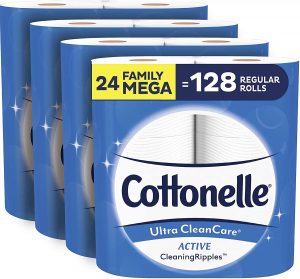
Thetford AquaSoft
Another septic-safe RV toilet tissue is Thetford AquaSoft but we found the cost is much more than Cottonelle and not as soft. We are sure its a great option, but unless we start having issues we are not going there! Thetford Aquasoft is marketed for RV's - designed to break down very easily. If you find that the Cottenelle isn't working, this could be a good option.
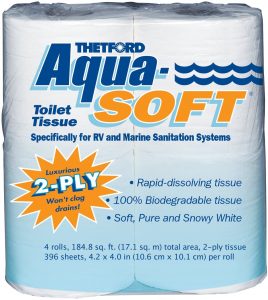
Scott Rapid-Dissolving
Scott Rapid-Dissolving is another popular choice for RV's. They claim it breaks down faster than the leading brand toilet paper. Scott Rapid-Dissolving is made for RV's but the rolls are smaller than regular toilet paper. We found you get much more paper with Cottonelle family mega rolls and it cost much less than Scotts.
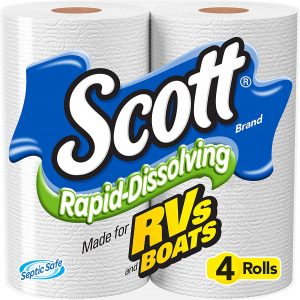
RV Internet
One of the most critical things for many people is having solid internet while on the road. We couldn't imagine not having the ability to be connected - I have had some form of always-on internet since 1997! We did a lot of research, and came to the following conclusions:
We needed at least two internet providers
Hardware should be mounted and set up like a house (no mifi as service)
Unlimited data if possible (with streaming, we expect to use hundreds of gigabytes per month)
Our Internet Providers
At the time of this writing, there are 3 big players. AT&T, Verizon and T-Mobile (Sprint is slowly become T-Mobile). From all our research, the best coverage comes from AT&T and Verizon. We were fortunate to get a pre-paid Verizon unlimited plan before they stopped selling it. AT&T has been more of a problem, and we are doing a post-paid iPad plan and a 3rd party reseller (which has proven to be a nightmare).
Our Setup
A few critical pieces make up our Internet strategy. The core of our setup is a Pepwave Max Transit DUO router with dual cat-12 modems.

This router is a beast (with a price tag to match). Peplink is mainly in the business of providing commercial solutions - think buses, police, fire and any other business that needs Enterprise-level gear and support. This means they are usually behind the curve in technology (in these markets, rolling out cool new things isn't a priority), but usually everything is just rock solid.
Having two modems (each with 2 SIM cards) lets this router do things that most cannot - it will test each connection and automatically make the fastest/best be the primary. For example, at the park we are currently at, we have Verizon as the primary, with a failover to AT&T. Even cooler, we also are connected to the parks wifi - which doesn't work very well but is available. That gives us a third option if the other options aren't working.
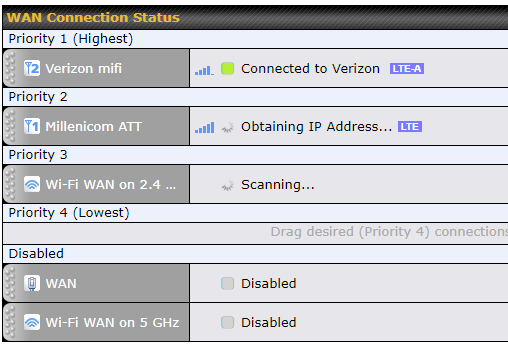
This is definitely somewhat of a luxury - you could have 2 jetpacks and make test both out when you get to a new location - or even change out the SIM's on the same jetpack. But connectivity is important to us, and portable jetpacks are not really designed to be on 24x7. And we found that this router does a better job compared to our Verizon 8800L with the Netgear MIMO antenna.
One reason we think we are getting better reception with this router is the fact we paired it up with a solid roof antenna, the Mobile Mark LTMG508 5in1 roof antenna.
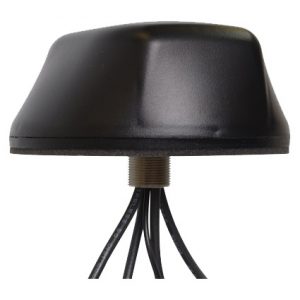
This antenna is smaller than it looks - easily fitting on most RV roofs. The only downside is you have to provide a ground plane - unlike the Poynting 5in1. For us this was no big deal - a small piece of galvanized metal from Home Depot worked perfectly. We ended up using a couple screws and sealant on top of our first AC unit. The antenna sticks just a few inches higher than everything else on our roof, and seems to be a good compromise of coverage and height. We hate to go ANY higher in height, but our Girard awnings create a metal ring around our entire roof (which came in handy for our solar install).
Temperature Monitoring - Vital for Your RV
We knew that moving from a house to an RV would require some changes - one of the biggest is being more diligent about your environment. Moving constantly and living in essentially a big black box guarantees that we will have wide swings in temperature throughout the year! Most of your things don't really care about these swings, but a few things do:
Pets
- Musical Instruments
- The Refrigerator
- Lithium Batteries
We have everything except pets, and wanted to be able to keep an eye on the coach as well as the basement (where the lithium batteries live). We wanted at least 3 sensors, and a display that we could set on the counter. In the end we looked at three different units:
AcuRite 02082M Home Temperature & Humidity Station
The AcuRite 02082M Home Temperature & Humidity Station is a really nice looking unit - full color, comes with 3 sensors and cost around $50 at the time of this writing.
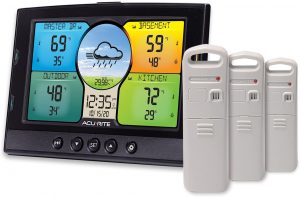
Ambient Weather WS-3000-X5
The Ambient Weather WS-3000-X5 is a powerhouse - comes with 3 sensors (around $85), or 5 sensors (around $100) and does temperature logging via an optional micro-SD card. The main unit can handle up to 8 sensors.
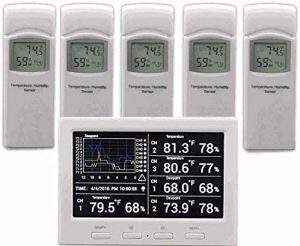
Keekit Outdoor Thermometer
The Keekit outdoor thermometer is pretty basic, lacking any sort of alarms. But it did have one advantage - when we bought it the unit only cost $31 with 3 sensors. It currently sits on our kitchen counter and monitors the freezer, the refrigerator, and the basement compartment where our batteries live. Although it isn't as fancy as the others, the price was right and so far has met our needs!
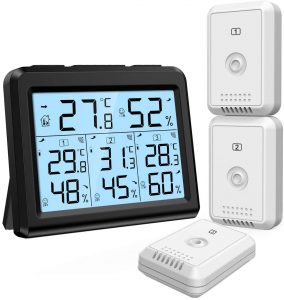
ZonePerfect Protein Bars
We take our diet pretty seriously - especially as we get older. Even though we work out at least 5 days a week, as the old saying goes, you can't out-exercise your diet. Calories in/calories out always applies.
Protein Bars
One of the tools in our toolbox is protein bars. Even though they have a fair amount of sugar in them, they make a good bridge between real meals (which we try to have as much as possible!).
ZonePerfect Protein bars are a good source of vitamins, protein and nutrition but are they really good for you? Well, we like them a lot. They are a great snack in between meals or if you want to get some protein before a workout or hike. What we also like about ZonePerfect protein bars is the variety of flavors and taste of them. Some of our favorite flavors are Oatmeal Chocolate Chunk, Chocolate Mint, Chocolate Chip Cookie Dough, and Fudge Graham.
